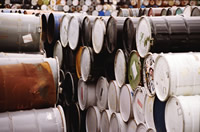
When is a hazardous waste container empty? Where there’s nothing in it, right? Not so fast. With hazardous wastes, even a small residue may present a hazard. That’s why you should train your workers on what “empty” really means when it comes to containers.
RCRA defines a container as “empty” by measuring the depth of the residue or by calculating the percent weight of residue left in a container (or in the inner liner removed from a container) that held hazardous waste. Containers that held compressed gas or acute hazardous waste have their own standard.
A container is considered empty if all waste has been removed that can be by pouring, pumping, or suction and:
- There is 1 inch or less of residue on the bottom of the container or inner liner;
- There is no more than 3 percent by weight in a container of 119 gallons or less; or
- There is no more than 0.3 percent by weight in a container with more than 119 gallons capacity.
Despairing ever getting your employees trained? It isn’t easy to fit it in—schedule-wise or budget-wise—but now there’s the Environmental Compliance Library from Employee Training Center. Train all your people, at their convenience, 24/7. Start Your Free Trial
A container that held hazardous waste compressed gas is empty only when the pressure in the container has reached atmospheric pressure. Proper precautions must be taken when opening containers of compressed gas in order to reach atmospheric pressure.
A container or inner liner that held an acute hazardous waste is empty if one of these conditions has been met:
- The container or inner liner has been triple-rinsed using a solvent capable of removing the hazardous waste.
- The container or inner liner has been cleaned by another method that has been shown to achieve the equivalent removal of triple rinse.
- In the case of a container, the inner liner that prevented contact of the hazardous waste has been removed.
Train on demand with Employee Training Center. Register today to start your FREE trial and get instant access to over 20 environmental compliance courses. Start Your Free Trial
8 Things You Can Do to Minimize Waste
Reduce the need for storage of hazardous wastes in containers to begin with by practicing these principles of waste minimization.
- Always share inventories of hazardous materials with other users in your facility, if possible. This reduces hazardous materials inventory. It will also reduce the number of containers that will reach the end of their shelf lives and be thrown away.
- When possible, substitute less hazardous chemicals for hazardous chemicals and less regulated chemicals for those that are heavily regulated in experiments, procedures, and processes.
- Select procedures that allow hazardous materials to be reused whenever it is practical and safe. Use smaller quantities of hazardous materials in procedures, experiments, and processes.
- Dispose of hazardous materials promptly at the end of their shelf life unless tests show that they are still useful.
- Know what you are using or storing. The identity of items must be known prior to disposal. Analyzing an unknown material to identify it is usually very expensive and timeconsuming.
- Optimize process operations to minimize the generation of hazardous waste.
- Transfer hazardous materials to other authorized users or dispose of them as hazardous waste if you are leaving employment.
- Finally, make it company practice to buy the smallest amount of material possible to minimize the disposal of unused materials.
